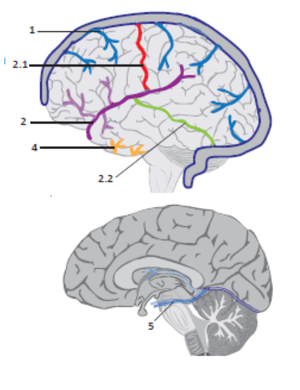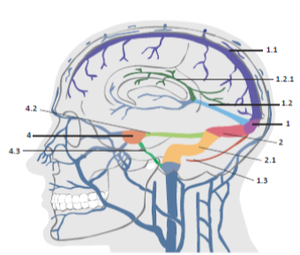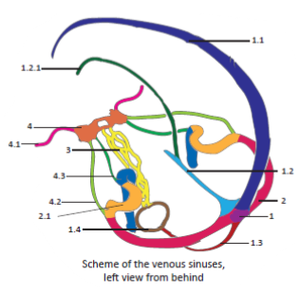Cranial veins, sinus durae matris, cerebral veins
From WikiLectures
Venous drainage[edit | edit source]
Structure: The veins of the brain have no muscular walls and no valves.
Superficial cerebral veins: collect blood from cerebral cortex -> drain into the Dural sinuses and are located in the subarachnoid space
- Superior cerebral veins (1): collect from superior hemisphere and drains into sagittal sinus
- Superficial middle cerebral vein (2): runs in the lateral sulcus, collect from lateral surface of the hemisphere and drains into cavernous sinus.
- Superior anastomosing vein (2.1): connect superficial middle vein and drains into superior vein (draining into superior sagittal sinus)
- Inferior anastomosing vein (2.2): connect superficial middle vein and drains into inferior vein (draining into transverse sinus)
- Deep middle cerebral vein: collect from insular lobe -> basal vein
- Inferior cerebral veins (4): collect from inferior hemisphere ->transverse sinus, superior and inferior petrosal sinuses
- Basal vein (5):Collects from inferior surface of frontal lobe and adjacent part of diencephalon -> great cerebral vein. the vein originates by the confluence of:
- Deep middle cerebral vein
- Anterior cerebral vein
- Striate veins
Deep cerebral vein: collect from diencephalon and deep parts of the hemispheres -> great cerebral vein
- Internal cerebral vein (1, paired): collect from the basal ganglia, internal capsule, septum, choroid plexus and white matter of hemispheres. Formed by the confluence of:
- Anterior vein of septum pellucidum: collect from septum and caudate nucleus.
- Superior choroid vein: collect from choroid plexus of lateral ventricle
- Superior thalmostriate vein: collect from thalamus, striatum and internal capsule
- Great cerebral vein (2, unpaired): formed by the union of right and left internal cerebral veins (under the splenium of corpus callosum) -> straight sinus
- Receive blood from basilar vein\
Dural sinuses[edit | edit source]
Their wall consists of a layer of endothelium and a sheet of dura mater. They are valve-less, and unable to collapse if damaged.
They drain to the internal jugular vein (superior bulb) and communicate with the extracranial veins via emissary veins
- Confluence of sinus (1): near internal occipital protuberance, collect from:
- o Superior sagittal sinus (1.1): pass in superior midline
- Arachnoid granulations project into it – CSF absorbed into the sinus
- o Superior sagittal sinus (1.1): pass in superior midline
- Straight sinus (1.2): at the junction of falx cerebri and tentorium cerebelli, collect from:
- Inferior sagittal sinus (1.2.1): in the inferior margin of falx cerebri
- Great cerebral vein
- Occipital sinus (1.3): originate near foramen magnum
- Marginal sinus (1.4, paired): around foramen magnum, connected to:
- Caudally: internal vertebral plexus
- Dorsally: occipital sinus
- Ventrally: basilar plexus
- Transverse sinus (2): In the groove for transverse sinus, continuous laterally:
- Sigmoid sinus (2.1): origin site of superior bulb of IJV with inferior petrosal sinus)
- Cavernous sinus (4, paired): Right and left are connected by anterior and posterior intercavernous sinuses, Collect from:
- superior ophthalmic vein
- sphenoparietal sinus (4.1): posterior margin of lesser wing
- superior petrosal sinus (4.2): interconnected with cavernous and sigmoid sinuses)
- inferior petrosal sinus (4.3): connect the cavernous sinus to jugular foramen
- The internal carotid artery passes in the sinus with CN III, CN IV, CN VI, CN V 1,2 )
- Basilar plexus (3, sinus): on the clivus
**Pictures from Memorix





